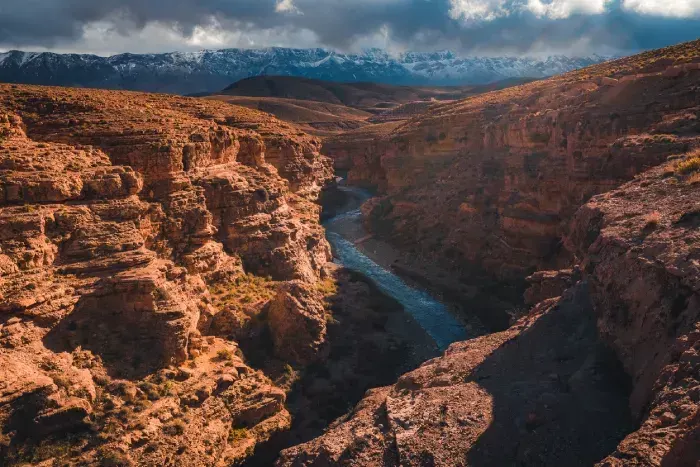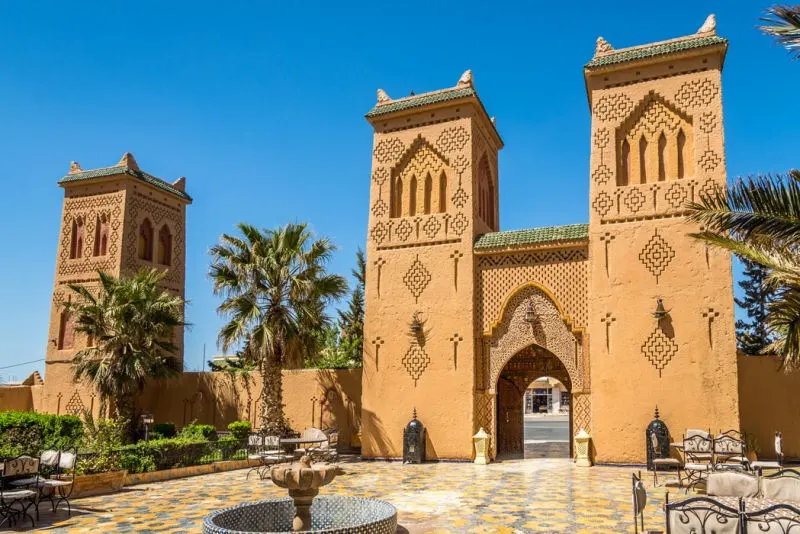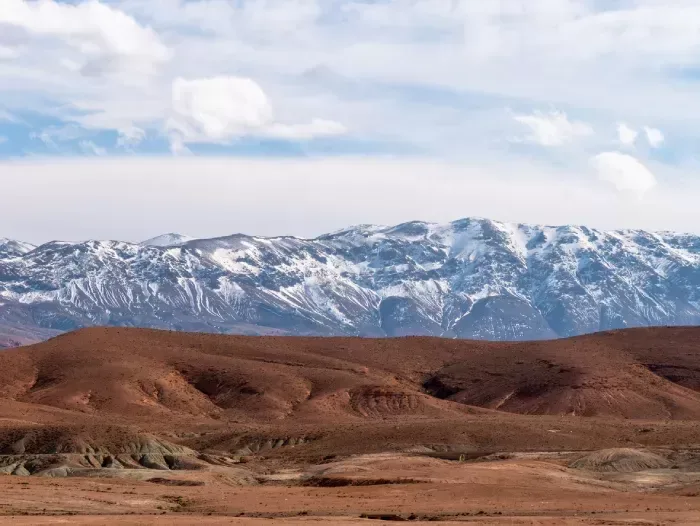Midelt Morocco
Situated in central Morocco between the Middle Atlas and High Atlas mountain ranges, Midelt Morocco. The city is highlighted by its beautiful nature and breathtaking landscapes.

Midelt Morocco sits majestically 4,948 feet above sea level. This prominent town nestles between the Middle Atlas and High Atlas mountain ranges. The local people call it the "Apple City," and its 55,304 residents make it a vital commercial center and a key stop for travelers between Fes and Merzouga.
The region's cold desert climate can send winter temperatures below -10 degrees Celsius. These unique weather conditions create an ideal environment for fruit cultivation. The Moulouya River's fertile banks support thriving orchards. Visitors can find abundant harvests of apples, walnuts, apricots, plums, and pomegranates. Midelt's agricultural wealth and temperate climate have transformed it into an appealing destination. Nature enthusiasts appreciate its beauty as it bridges the Atlas Mountains and the Sahara Desert.
Where is Midelt Located
Midelt, the capital of Midelt Province, lies in Morocco's Drâa-Tafilalet region. This town stands in the high plains around the Moulouya River and creates a natural gateway between the urban north and the desert south.
Between Atlas Mountains and the Sahara
You'll find Midelt at 32.684174° N and 4.732189° W, right between the Middle Atlas and High Atlas mountain ranges. The town sits along the main road that links Fes and Meknes to Errachidia, making it a vital stop for travelers. The surrounding high plains create a stunning view where mountains blend into desert landscapes.
Distance from major cities
Midelt's central location puts several major Moroccan cities within easy reach:
- Fes: 152 kilometers
- Meknes: 154 kilometers
- Rabat: 244 kilometers
- Casablanca: 285 kilometers
- Marrakesh: 328 kilometers
Travelers heading south to the Sahara will find Errachidia 137 kilometers away. The town also connects naturally with nearby communities like Zaida, Boumia, and Itzer - all within 88 kilometers of Midelt's center.
Here's how long it takes to reach Midelt from major northern cities:
- From Fez: 5 hours 21 minutes covering 341.8 kilometers
- From Ifrane: 4 hours 9 minutes spanning 273.6 kilometers
- From Meknes: 5 hours 10 minutes across 326 kilometers
Midelt's location makes it perfect to explore both the Atlas region and desert landscapes. People traveling from Meknes to the Sahara often stop here before continuing to Merzouga, one of the main entrances to the Sahara Desert.
The area around Midelt features remarkable spots like the Reservoir du Barrage A Hassan Addakhil and the Ziz Valley near Errachidia. This unique spot between mountains and desert creates a transition zone where Atlas mountains gradually fade into the vast Sahara, giving visitors a chance to see Morocco's diverse landscape.
Plan your Fabulous Trip from Morocco Travel Packages Now!

Know about the history, weather, and what to do in Midelt:
History and People of Midelt
In the first half of the 20th century, during the French occupation, Midelt was constricted. The French army benefited from it as a source of lead, gypsum, and other minerals. The occupation of the French colony over the city affected the population; they speak both Arabic and French, as well as the rest of Morocco. The city has a population of 55,304, who are known for being hospitable and friendly.
Local Life and Culture: Midelt's Living Heritage
Midelt's cultural essence flows through ancient Berber bloodlines, where generations of tradition pulse through daily existence. This predominantly Berber realm resonates with Central Atlas Tamazight (Ait Ayache), while Darija, Standard Arabic, and French weave through conversations like golden threads.
Berber Heritage Tapestry
Ancient Berber artistry flourishes in masterful hands, where each carpet, ceramic vessel, and wooden treasure carries ancestral wisdom. Musical heritage echoes through mountain valleys as traditional flutes and drums summon communities to celebration. Berber hospitality manifests as sacred ritual - homes open their doors to travelers, offering sweet mint tea ceremonies and time-honored feasts that speak of centuries-old traditions.
Agricultural Dynasty
Midelt's crowned glory rests in its apple empire, a distinction earning its royal title: "Apple City". This agricultural realm commands Morocco's apple production, yielding between 800,000 and one million tons annually - more than half the kingdom's harvest. This pomological dominion creates:
- 2.2 million working days yearly
- Sustenance for 60,000 souls
- More than 100 distinct apple varieties
The mighty Moulouya River nurtures a cornucopia beyond apples - walnuts, apricots, plums, pomegranates, wheat, and corn flourish in its embrace. Such abundance has elevated Midelt to agricultural sovereignty from Moulouya's banks to Jebel Ayachi's shadow.
Market Symphony
Sunday's souk orchestrates a magnificent gathering, where carpet weavers and apple merchants present their seasonal treasures. These ancient marketplaces serve as:
- Galleries for master artisans
- Farmers' grand exhibitions
- Culinary theaters offering Bissara and Harira's aromatic pleasures
Within these labyrinthine passages, merchants become storytellers, sharing tales woven through generations. The marketplace architecture itself stands as a testament to time's passage, where Berber ingenuity meets French colonial influence in stone and wood.

Things to Do in Midelt
Since Midelt is surrounded by Atlas Mountains chains, the main activities that can be enjoyed the most are hiking and trekking. Visitors can also enjoy riding camels, feeding them, seeing springs at the foot of the mountain, and enjoying many Berber villages. People are very friendly, so guides might make you do many local activities.
Here are some activities for you to do while being in Midelt:

Customize Your Dream Vacation!
Get in touch with our local experts for an unforgettable journey.
Plan Your TripTrekking Cirque Jaffar
Located 25 km southwest of Midelt, Cirque Jaffar will offer you the chance to get a few glimpses of traditional Berber villages and to take in splendid mountain scenery and views. You will get through Jebel Ayachi, the highest mountain in the East High Atlas (3.737 m).
Hiking Through Berber Villages in Midelt
Hiking through the Berber Villages in Midlet will make you appreciate the small things in life, giving yourself the chance to contemplate and meditate. It is beautiful how the Berber people reflect their simplicity and warm vibes on the travellers.
Natural Attractions: Midelt's Geological Theatre
Midelt presides over a remarkable confluence of geological wonders, where mountain massifs and desert expanses craft nature's grandest exhibition. This extraordinary geographical nexus presents spectators with an ever-changing panoramic masterpiece.
Mountain Majesty
Jebel Ayachi commands the celestial realm, its summit piercing the heavens at 3,757 meters above sea level. These ancient peaks wear their snow-crowned glory against azure skies, their magnificence particularly pronounced from the austere plateau perched beyond 1,500 meters.
The mountainous realm reveals:
- Berrem Gorge's serpentine splendor, where water and stone wage eternal dialogue
- Ancient cedar sentinels standing guard across Middle Atlas slopes
- Time-honored Berber settlements woven into valley folds
Cirque Jaffar, lying 25 kilometers southwest, unfolds its geological manuscript alongside centuries-old Berber dwellings. Here, nature's artistry echoes the sculptural magnificence found in North American desert landscapes.
Desert Grandeur
Beyond Midelt's domain, geological forces orchestrate a dramatic metamorphosis from Morocco's emerald north to its golden south. The landscape unveils:
The legendary Ziz Valley stretches forth, its palm grove oasis ranking among Earth's most extensive. Geological millennia have carved remarkable formations, their rock faces bearing nature's spiral signatures. This extraordinary realm presents medieval kasbahs silhouetted against snow-mantled peaks - a singular portrait of Morocco's geographical diversity.
Clear desert atmospheres bestow perfect conditions upon astronomical observers. Unimpeded celestial vistas attract stargazers, establishing the region as an astronomical sanctuary.
Dawn and dusk emerge as nature's finest hours when light performs its most spectacular displays across this varied terrain. These moments paint extraordinary shadows across mountain ridges and desert plains, revealing the sublime contrasts that establish Midelt's natural heritage among Morocco's finest.

Midelt's Remarkable Climate Tapestry
Midelt's meteorological identity emerges from its cold desert classification (BSk), weaving an intricate pattern of seasonal metamorphoses that captivate meteorologists and travelers alike.
Summer's Celestial Theatre
July orchestrates nature's grand thermal performance, conducting daily temperatures to crescendos of 34.1°C (93.4°F). The celestial apex arrives near July 22, when mercury occasionally ascends to remarkable heights of 43.2°C (109.8°F). Summer skies display extraordinary clarity, with July boasting a mere 9% chance of cloud cover. These astronomical conditions birth perfect moments for desert odysseys and geological expeditions.
Winter's Arctic Ballet
January unveils nature's cooling masterpiece, as average temperatures gracefully descend to 4.6°C (40.3°F). Arctic influences occasionally command temperatures below -10°C, though such dramatic performances rarely extend beyond five days. Winter's artistic brush paints the landscape with pristine snow, crafting scenes that defy Morocco's desert reputation. Crystal-clear winter mornings beckon adventurers toward desert horizons and cultural discoveries.
Seasonal Symphony
Spring (March-April) and autumn (September-October) emerge as nature's finest compositions. These transitional movements present:
- Spring's gentle thermal dance between 16.9°C (62.4°F) and 20.0°C (68.0°F)
- Autumn's measured descent from 27.7°C (81.9°F) to 22.4°C (72.3°F)
Atmospheric moisture performs its annual rhythm, reaching its zenith at 59.92% in December while falling to a mere 26.75% during July's desert area. Solar brilliance achieves perfection in July, blessing the region with 12.65 daily hours of celestial illumination.
This meteorological masterpiece, conducted by mountain winds and desert thermals, establishes Midelt among Morocco's most climatically sophisticated inland sanctuaries. Here, altitude and Atlantic influences compose a weather symphony unlike any other in North Africa.
FAQs
Q1. What makes Midelt unique among Moroccan destinations?
Midelt is uniquely positioned between the Atlas Mountains and the Sahara Desert, offering visitors a blend of mountain and desert landscapes. It's known for its temperate climate, apple orchards, and rich Berber culture, making it an ideal stop for travelers seeking authentic experiences away from typical tourist routes.
Q2. When is the best time to visit Midelt?
The best times to visit Midelt are during spring (March-April) and autumn (September-October). These seasons offer pleasant temperatures ranging from 16.9°C to 27.7°C, providing comfortable conditions for outdoor activities and exploring both the mountainous terrain and desert landscapes.
Q3. What are some popular activities to do in Midelt?
Popular activities in Midelt include hiking and trekking in the Atlas Mountains, exploring local markets like the Sunday souk, visiting apple orchards, and experiencing Berber culture. You can also enjoy camel rides, visit nearby Berber villages, and take in the stunning views of Jebel Ayachi mountain.
Q4. How does Midelt's climate differ from other parts of Morocco?
Midelt has a unique cold desert climate, with hot summers and cold winters. Summer temperatures can reach up to 34.1°C, while winter temperatures can drop below -10°C. This climate creates perfect conditions for fruit cultivation, particularly apples, making Midelt known as the "Apple City" of Morocco.
Q5. What cultural experiences can visitors expect in Midelt?
Visitors to Midelt can immerse themselves in rich Berber traditions. The town offers opportunities to experience local hospitality, taste traditional cuisine, explore vibrant markets, and witness the craftsmanship of local artisans. The area is known for its intricate rugs, pottery, and wooden artifacts that reflect generations of Berber culture.


































